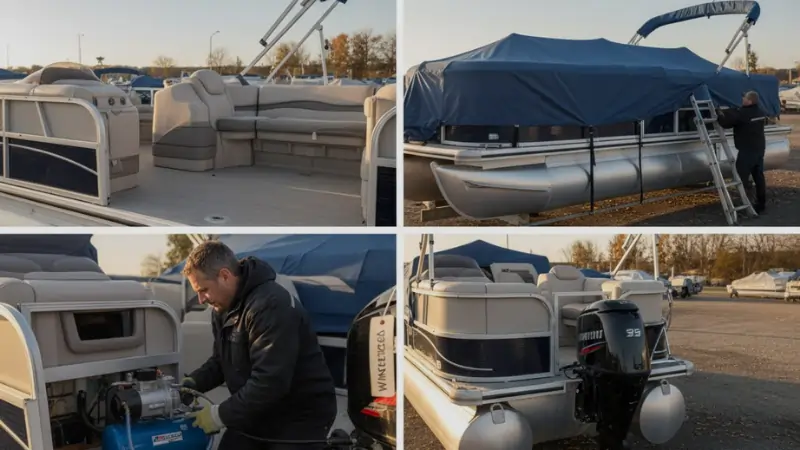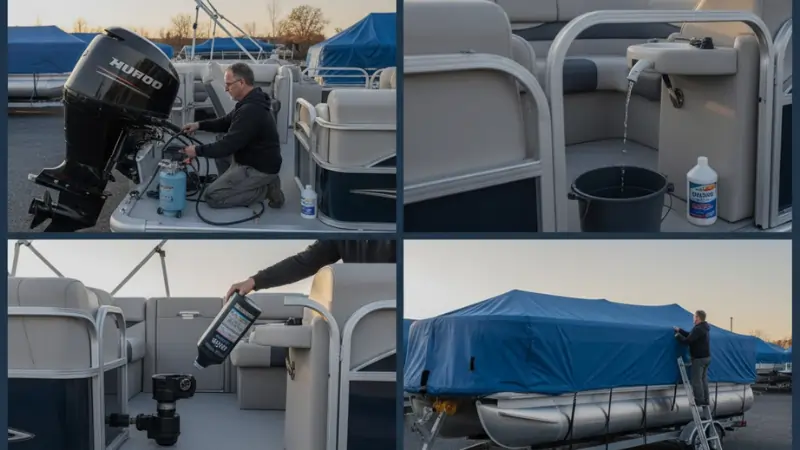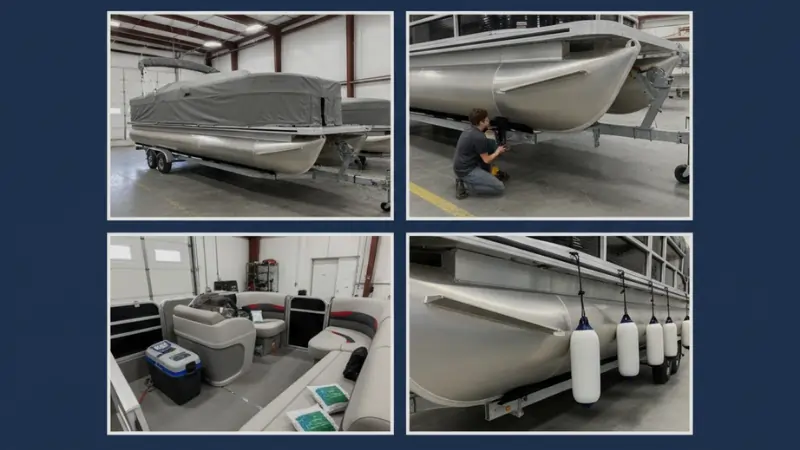How to Winterize a Pontoon Boat: Step-by-Step Guide for Safe Storage
Winter hits fast, and your pontoon boat needs protection. You spent all summer out on the water, making memories with family. Now, cold weather threatens to damage it if you leave things as they are. So, winterizing becomes that key job to keep everything running smooth next year, especially if you’re wondering how to winterize a pontoon boat without turning it into a big ordeal.
For example, freezing temps can burst pipes or ruin the engine. But when you follow a simple plan, you avoid those headaches. Plus, it saves cash on big repairs down the line. Trust me, I’ve seen boats sit out uncovered and pay the price.
Why Winterizing Your Pontoon Boat Matters

Cold snaps turn water inside your boat into ice. That expansion cracks hoses and blocks fast. So, you end up with leaks come spring. Nobody wants to start the season fixing that mess.
Beyond the basics, neglect shortens your boat’s life. Think about the motor sitting idle with old fuel. It gums up and won’t start easy. That’s why smart owners tackle this right after the last trip. Even people switching from their own pontoons to booking yacht rentals NYC know the difference a well-maintained boat makes.
What You’ll Need Before You Start
Start with cleaning gear like a hose, bucket, and soft soap. Then grab sponges or cloths for wiping down spots. These keep grime from setting in during storage. You stay dry and efficient too.
For the engine side, pick up antifreeze rated for boats. Add fuel stabilizer and some fogging oil. Don’t skip wrenches or a funnel either. Having it all ready cuts down on frustration.
Step-by-Step Guide to Winterizing a Pontoon Boat

Go through each step one at a time. You build confidence as you go. First comes the clean-up, then the mechanical bits. This order makes sense for most folks.
Rushing through skips details that matter. Instead, set aside a full afternoon. Work steady, and check off items. Your pontoon ends up ready for warmer days.
Step 1 – Clean the Exterior and Interior
Hit the outside with a gentle wash first. Summer salt and dirt cling tight otherwise. Rinse well with fresh water next. Then pat dry to dodge water marks.
Move inside to seats and carpets. Vacuum up crumbs and sand right away. Wipe counters with a mild cleaner. A spotless interior fights off smells later on.
Step 2 – Remove Gear and Accessories
Pull life vests and anchors out now. Dry them off before boxing up. Fishing tackle goes in labeled bins too. This way, you grab everything quick in spring.
Cushions come off if you can. Hang them to air out fully. Rod holders detach easy on most models. Stored gear stays in top shape.
Step 3 – Prepare and Protect the Engine
Run fresh water through the cooling system. Debris from lake water builds up quick. Drain it all out afterward. Clean lines mean no surprises.
Change the oil while the motor’s warm. Pour in new stuff slowly. Fog the insides with spray oil next. This coats parts and blocks rust.
Step 4 – Add Antifreeze and Fuel Stabilizer
Empty any standing water from pumps. Then pour in the pink antifreeze mix. Cycle it through till it flows out clear. Full coverage stops freezes.
Top off the tank with stabilizer-treated gas. Half full works best to cut moisture. Shake the can well before adding. Fuel stays fresh for months.
Step 5 – Disconnect and Store the Battery
Unhook the positive cable first. Then the negative for safety. Scrub terminals clean with baking soda mix. Sparks stay far away.
Charge it up one last time. Find a garage shelf for it. Keep temps above freezing. Easy access means no hunting around later.
Step 6 – Grease, Lubricate, and Seal Moving Parts
Squeeze grease into fittings on lifts. Turn handles to spread it even. Hinges get a light coat too. Metal stays loose and quiet.
Spray lube on throttle cables. Check door seals for cracks. Rub in silicone there. Weather stays out where it belongs.
Step 7 – Cover and Store Your Pontoon Boat Properly
Fit a breathable cover over the whole thing. Tie it down snug against wind. Avoid plastic that traps damp. Airflow keeps mold at bay.
Park on blocks to lift the frame. Choose a shed or driveway spot. Steer clear of low areas that flood. Secure spots last all winter.
Tips for Storing Your Pontoon Boat Over Winter

Level the trailer under the boat. Tilts cause frame strain over time. Tighten tie-downs every few weeks. Winds loosen them without notice.
Scatter peppermint pouches around. Mice chew wires if you ignore them. Tape over vent gaps too. Small steps block big problems.
Common Mistakes to Avoid When Winterizing a Pontoon Boat
People forget to flush salt from the outboard. It corrodes fast in storage. Run that hose every time. Clean motors run longer.
Batteries left connected die quick in cold. Disconnect them without fail. Test voltage before packing away. Dead ones spoil openers.
Final Thoughts – How to Winterize a Pontoon Boat
You put in the work now for easy fun later. That pontoon waits patient through snow. Launch day feels great without worries. Hit the water soon.





